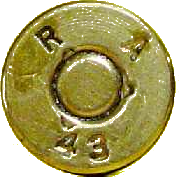Ysterhout Dot Net
Content provided by Michiel Meyer, hosted with permission
The main reason we clean the brass is to make defects in the cases more visible. You might miss a crack in the case if it’s dirty. Look for any cracks, bulges and the telltale sign of case separation just above the rim of the case. (will be in form of a noticeable ring which can be felt with your finger). Discard all suspect cased cases. If in doubt, discard. It is better to waste 50c on a case than to have to sit with a damaged firearm and / or a broken hand.
Necked down cases (like rifles and 7.62x25 Tokarev) tends to develop a crack on the case mouth. Included in the picture below is a rifle case (7.62x39) as reference.

Some people also prefer to use a case gauge as an additional check to make sure the case complies dimensionally to all the relevant specifications. This is a great tool if you shoot a handgun with very tight tolerances on it’s combustion chambers. The Glock range of pistols comes to mind. If you do not own a case gauge, then the barrel of you pistol can also be used to check if the round would load correctly of not.
Below is a case which looks physically ok, but fails the case gauge check. This case could give trouble when loading it into some pistols.
It should look like this when it passes the case gauge check.




